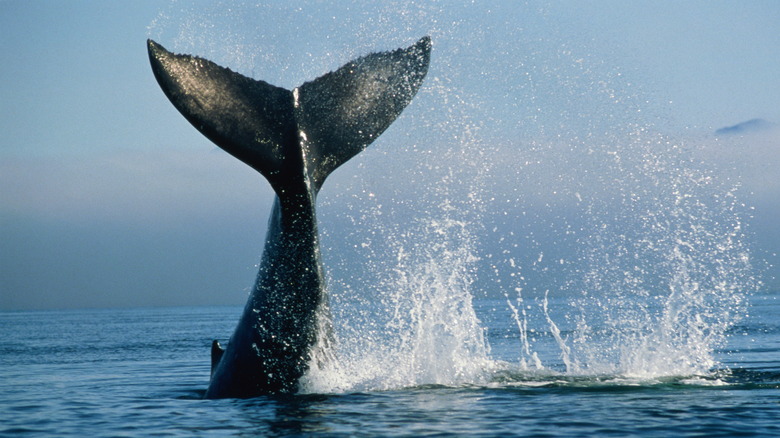For Whales In A California Study, Microplastics Are On The Menu
In 1907, chemist Leo Baekeland created the first plastic substance. Around 20 years later, petroleum and chemical industries wanted to find a use for waste materials from their oil and gas production. This led to the creation of the plastic that we know today. By World War II, plastic became part of cables. It eventually led to the rise of plastic bags, Tupperware, and Nylon (per Science Museum).
Britannica states that by the 1960s and '70s, scientists found plastic in plankton. Since then, beaches and oceans have been focal points of plastic pollution's environmental devastation. There are now multiple "garbage patches" in most of the globe's oceanic regions. Despite decades of public awareness surrounding this issue, plastic use remains rampant, but difficult to avoid in day-to-day activities no matter where in the world one lives. Just like the discovery of plastic within plankton studies of the mid-20th century, plastic is still finding its way inside vulnerable marine animals which are already suffering catastrophic drops in population.
Microplastics come from man-made products
Lesser-known forms of plastic are microplastics. These are bits of plastic smaller than five millimeters in size. They sometimes come in the form of microbeads in toothpaste or skincare products. Larger plastic items also shed these particles, including plastic containers out of which we eat and drink. According to Discover Magazine, glitter counts as a harmful microplastic as well.
In 2022, scientists published their findings after tagging 191 whales off the coast of California. This sample included blue, fin, and humpback whales. Different species of whales feed in different ways, but many species of filter-feeding whales take in massive amounts of water and prey in each gulp. Whales that eat krill take in more water and prey than fish-eating whales. This means that whales like blue whales ingest more microplastics than humpbacks. However, all are at risk of ingesting microplastics as 99% of microplastic ingestion is from food. Blue whales likely ingest 1 billion particles daily and humpbacks take in around 200,000 particles. All baleen whales (which includes blue, fin, and humpback) feed at depths with the highest amounts of microplastics.
Plastic ingestion is expected to increase
Aquatic life is most affected by microplastics, but as previously mentioned, they come from products used by humans. This means that humans are not immune to microplastics. In fact, no species is immune. They have been found in table salt, drinking water, beer, and even rainfall. Despite studies on microplastics, most of which have been done on ocean dwellers, the variety of size and shape of microplastics makes their effects unclear as of 2022. However, zooplankton reproduce slower when exposed to microplastics. This makes scientists worry about reproduction of large organisms as well. Plastic ingestion is only expected to increase in the future. Ingesting small amounts of plastic may not be a big deal, but filling up on plastic instead of nutritional food cannot be a positive thing (per Nature.com).
Even if humans are not the first to feel the effects of ingesting plastic of any size, the wildlife with which we share the planet are vital to human life. They affect the environment, including food sources for humans. Humans don't often eat whales, but we do eat some of the same things that they do. If they're ingesting plastic, so are we.


